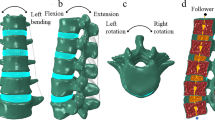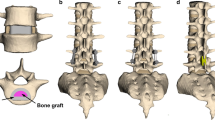Abstract
In lumbar spinal fusion, the titanium cage tends to cause stress shielding due to their high elastic modulus, which can lead to degenerative lesions in adjacent spinal segments. Furthermore, polyetheretherketone (PEEK) cages have certain material characteristics that do not promote bone ingrowth and fusion stability. In this study, a new cage was designed, and its biomechanical performance in percutaneous endoscopic posterior lumbar interbody fusion (PE-PLIF) was analyzed using the finite element (FE) method. A complete model of the L4–L5 lumbar spine was established, and static and harmonic vibration FE analysis models were developed based on it. The biomechanical properties of titanium, PEEK, and combined cage in PE-PLIF fusion were compared. The strain capacity of the combined fusion increased by 9.5% when compared to the titanium fusion. The surgical model under the combined fusion reduces the L5 endplate stress by 12% in the forward flexion condition and the fusion stress by 17% in the vibration condition compared to the model supported by the titanium fusion, and the differences in screw stress and mobility among the three models are not significant in multiple conditions. Consequently, the combined cage demonstrates a certain reduction in the stress-shielding effect when compared to the titanium cage; it has better fusion effect and provides theoretical support and guidance for the design of the clinical fusion cage.
Graphical abstract
















Similar content being viewed by others
References
Zhao X, Ma H, Han H, Zhang L, Tian J, Lei B et al (2022) Precision medicine strategies for spinal degenerative diseases: injectable biomaterials with in situ repair and regeneration. Mater Today Bio 16:100336. https://doi.org/10.1016/j.mtbio.2022.100336
Yan Y, Li J, Yu J, Wang Y, Dong H, Sun Y et al (2022) Biomechanical evaluation of two fusion techniques based on finite element analysis: percutaneous endoscopic and minimally invasive transforaminal lumbar interbody fusion. Med Nov Technol Devices 16:100138. https://doi.org/10.1016/j.medntd.2022.100138
Turner CH (1992) Functional determinants of bone structure: beyond Wolff’s law of bone transformation. Bone 13(6):403–409. https://doi.org/10.1016/8756-3282(92)90082-8
Yang JJ, Kim D-M, Park S (2023) Comparison of fusion, subsidence, and clinical results between 3D-printed porous titanium cage and polyetheretherketone cage in posterior lumbar interbody fusion: a minimum of 2 years follow-up. World Neurosurg 177:e732–e741. https://doi.org/10.1016/j.wneu.2023.06.132
Wu Y-J, Wang C-Y, Feng K-C, Chien RR, Mana-ay H, Kung S-Y et al (2023) Ti-6Al-4V intervertebral fusion cage with compatible stiffness, enhanced fatigue life, and osteogenic differentiation. J Alloy Compd 957:170450. https://doi.org/10.1016/j.jallcom.2023.170450
Kurtz SM (2019) Chapter 15 - Development and clinical performance of PEEK intervertebral cages. In: Kurtz SM (ed) PEEK Biomaterials handbook (Second Edition). William Andrew Publishing, pp 263–280
Pei X, Wang L, Wu L, Lei H, Zeng Z, Wang L et al (2023) In-situ synthesized hydroxyapatite whiskers on 3D printed titanium cages enhanced osteointegration in a goat spinal fusion model. Mater Des 233:112270. https://doi.org/10.1016/j.matdes.2023.112270
Zhou Z, Han X, Gao WJ, Li YL, Yu WQ, Yang SH et al (2022) Fabrication and mechanical properties of different types of carbon fiber reinforced polyetheretherketone: a comparative study. J Mech Behav Biomed Mater 135:105472. https://doi.org/10.1016/j.jmbbm.2022.105472
Li CS, Vannabouathong C, Sprague S, Bhandari M (2015) The use of carbon-fiber-reinforced (CFR) PEEK material in orthopedic implants: a systematic review. Clin Med Insights Arthritis Musculoskelet Disord 8:33–45. https://doi.org/10.4137/cmamd.S20354
Yang JJ, Chang B-S, Yeom JS, Lee JH, Yu CH, Lee C-K (2010) Subsidence and nonunion after anterior cervical interbody fusion with stand-alone polyetheretherketone (PEEK) cage. Spine J 10(9, Supplement):S82–S3. https://doi.org/10.1016/j.spinee.2010.07.221
Jain P, Rana M, Biswas JK, Khan MR (2020) Biomechanics of spinal implants-a review. Biomed Phys Eng Express 6(4):042002. https://doi.org/10.1088/2057-1976/ab9dd2
Kashii M, Kitaguchi K, Makino T, Kaito T (2020) Comparison in the same intervertebral space between titanium-coated and uncoated PEEK cages in lumbar interbody fusion surgery. J Orthop Sci 25(4):565–570. https://doi.org/10.1016/j.jos.2019.07.004
Kienle A, Graf N, Wilke H-J (2016) Does impaction of titanium-coated interbody fusion cages into the disc space cause wear debris or delamination? Spine J 16(2):235–242. https://doi.org/10.1016/j.spinee.2015.09.038
Jia C-Q, Zhang Z, Cao S-Q, Wang T-J, Yu H-C, Wang W-X et al (2023) A biomimetic gradient porous cage with a micro-structure for enhancing mechanical properties and accelerating osseointegration in spinal fusion. Bioact Mater 23:234–246. https://doi.org/10.1016/j.bioactmat.2022.11.003
Polikeit A, Ferguson SJ, Nolte LP, Orr TE (2003) Factors influencing stresses in the lumbar spine after the insertion of intervertebral cages: finite element analysis. Eur Spine J 12(4):413–420. https://doi.org/10.1007/s00586-002-0505-8
Guo L-X, Li W-J (2019) A biomechanical investigation of thoracolumbar burst fracture under vertical impact loads using finite element method. Clin Biomech 68:29–36. https://doi.org/10.1016/j.clinbiomech.2019.05.018
Zhang C, Shi J, Chang M, Yuan X, Zhang R, Huang H et al (2021) Does osteoporosis affect the adjacent segments following anterior lumbar interbody fusion? A finite element study. World Neurosurg 146:e739–e746. https://doi.org/10.1016/j.wneu.2020.11.005
He L, Feng H, Ma X, Chang Q, Sun L, Chang J et al (2021) Percutaneous endoscopic posterior lumbar interbody fusion for the treatment of degenerative lumbar diseases: a technical note and summary of the initial clinical outcomes. Br J Neurosurg 1–6. https://doi.org/10.1080/02688697.2021.1929838
Fan W, Guo L-X (2018) The role of posterior screw fixation in single-level transforaminal lumbar interbody fusion during whole body vibration: a finite element study. World Neurosurg 114:e1086–e1093. https://doi.org/10.1016/j.wneu.2018.03.150
Yamamoto I, Panjabi M, Crisco T, Oxland T (1989) Three-dimensional movements of the whole lumbar spine. J Biomech 22(10):1103. https://doi.org/10.1016/0021-9290(89)90523-X
Shim CS, Park SW, Lee S-H, Lim TJ, Chun K, Kim DH (2008) Biomechanical evaluation of an interspinous stabilizing device, locker. Spine 33(22):E820–E827. https://doi.org/10.1097/BRS.0b013e3181894fb1
Qin Y, Zhao B, Yuan J, Xu C, Su J, Hao J et al (2022) Does cage position affect the risk of cage subsidence after oblique lumbar interbody fusion in the osteoporotic lumbar spine: a finite element analysis. World Neurosurg 161:e220–e228. https://doi.org/10.1016/j.wneu.2022.01.107
Xiao Z, Wang L, Gong H, Zhu D, Zhang X (2011) A non-linear finite element model of human L4–L5 lumbar spinal segment with three-dimensional solid element ligaments. Theor Appl Mech Lett 1(6):064001. https://doi.org/10.1063/2.1106401
Zhang L, Li H-M, Zhang R, Zhang H, Shen C-L (2021) Biomechanical changes of adjacent and fixed segments through cortical bone trajectory screw fixation versus traditional trajectory screw fixation in the lumbar spine: a finite element analysis. World Neurosurg 151:e447–e456. https://doi.org/10.1016/j.wneu.2021.04.061
Biswas JK, Rana M, Majumder S, Karmakar SK, Roychowdhury A (2018) Effect of two-level pedicle-screw fixation with different rod materials on lumbar spine: a finite element study. J Orthop Sci 23(2):258–265. https://doi.org/10.1016/j.jos.2017.10.009
Shimooki Y, Murakami H, Nishida N, Yan H, Oikawa R, Hirooki E et al (2023) Finite element modeling for biomechanical comparisons of multi-level transforaminal, posterior, and lateral lumbar approaches to interbody fusion augmented with posterior instrumentation. World Neurosurg. https://doi.org/10.1016/j.wneu.2023.11.121
Fan W, Guo L-X (2021) Prediction of the influence of vertical whole-body vibration on biomechanics of spinal segments after lumbar interbody fusion surgery. Clin Biomech 86:105389. https://doi.org/10.1016/j.clinbiomech.2021.105389
Ge T, Hu B, Zhang Q, Xiao J, Wu X, Xia D (2023) Biomechanical evaluation of two-level oblique lumbar interbody fusion combined with posterior four-screw fixation: a finite element analysis. Clin Neurol Neurosurg 225:107597. https://doi.org/10.1016/j.clineuro.2023.107597
Massaad E, Shin J, Kiapour A (2023) P8. Comparative finite element analysis of toggling resistance of anatomically optimized versus conventional pedicle fixation anchors in osteoporotic vertebral bodies. Spine J 23(9, Supplement):S112. https://doi.org/10.1016/j.spinee.2023.06.233
Yan Y, Yu J, Wang Y, Dong H, Zhang K, Wang Y et al (2023) A newly designed personalized interbody fusion cage and its biomechanical analysis. 39(9):623047. https://doi.org/10.1007/s10409-023-23047-x
Chen Z, Chen Y, Ding J, Yu L (2023) Blending strategy to modify PEEK-based orthopedic implants. Compos B Eng 250:110427. https://doi.org/10.1016/j.compositesb.2022.110427
Mobbs RJ, Phan K, Assem Y, Pelletier M, Walsh WR (2016) Combination Ti/PEEK ALIF cage for anterior lumbar interbody fusion: early clinical and radiological results. J Clin Neurosci 34:94–99. https://doi.org/10.1016/j.jocn.2016.05.028
Cuzzocrea F, Ivone A, Jannelli E, Fioruzzi A, Ferranti E, Vanelli R et al (2019) PEEK versus metal cages in posterior lumbar interbody fusion: a clinical and radiological comparative study. Musculoskelet Surg 103(3):237–241. https://doi.org/10.1007/s12306-018-0580-6
Campbell PG, Cavanaugh DA, Nunley P, Utter PA, Kerr E, Wadhwa R et al (2020) PEEK versus titanium cages in lateral lumbar interbody fusion: a comparative analysis of subsidence. Neurosurg Focus 49(3):E10. https://doi.org/10.3171/2020.6.Focus20367
Castro APG, Wilson W, Huyghe JM, Ito K, Alves JL (2014) Intervertebral disc creep behavior assessment through an open source finite element solver. J Biomech 47(1):297–301. https://doi.org/10.1016/j.jbiomech.2013.10.014
Volz M, Elmasry S, Jackson AR, Travascio F (2022) Computational modeling intervertebral disc pathophysiology: a review. Front Physiol 12. https://doi.org/10.3389/fphys.2021.750668.
Abbasi-Ghiri A, Ebrahimkhani M, Arjmand N (2022) Novel force–displacement control passive finite element models of the spine to simulate intact and pathological conditions; comparisons with traditional passive and detailed musculoskeletal models. J Biomech 141:111173. https://doi.org/10.1016/j.jbiomech.2022.111173
Garay RS, Solitro GF, Lam KC, Morris RP, Albarghouthi A, Lindsey RW et al (2022) Characterization of regional variation of bone mineral density in the geriatric human cervical spine by quantitative computed tomography. Plos One 17(7). https://doi.org/10.1371/journal.pone.0271187
Al-Barghouthi A, Lee S, Solitro GF, Latta L, Travascio F (2020) Relationships among bone morphological parameters and mechanical properties of cadaveric human vertebral cancellous bone. JBMR plus 4(5):e10351-e. https://doi.org/10.1002/jbm4.10351
Elmasry S, Asfour S, Travascio F (2017) Effectiveness of pedicle screw inclusion at the fracture level in short-segment fixation constructs for the treatment of thoracolumbar burst fractures: a computational biomechanics analysis. Comput Methods Biomech Biomed Engin 20(13):1412–1420. https://doi.org/10.1080/10255842.2017.1366995
Elmasry SS, Asfour SS, Travascio F (2018) Finite element study to evaluate the biomechanical performance of the spine after augmenting percutaneous pedicle screw fixation with kyphoplasty in the treatment of burst fractures. J Biomech Eng-Trans Asme 140(6). https://doi.org/10.1115/1.4039174
Vinyas, Bhat SK, Adhikari R, Bhat NS (2023) In-silico model development and validation of the L5-S1 spinal unit. Cogent Eng 10(1):2184446. https://doi.org/10.1080/23311916.2023.2184446.
Meenashisundaram GK, Wang N, Maskomani S, Lu S, Anantharajan SK, Dheen ST et al (2020) Fabrication of Ti + Mg composites by three-dimensional printing of porous Ti and subsequent pressureless infiltration of biodegradable Mg. Mater Sci Eng, C 108:110478. https://doi.org/10.1016/j.msec.2019.110478
Funding
This work was supported by the National Natural Science Foundation of China (No. 12272250, 12372310), the China Postdoctoral Science Foundation (2020M680913), the Shanxi Scholarship Council of China (2022–081), the Shanxi Postgraduate Innovation Project, and the Shanxi Huajin Orthopaedic Public Foundation.
Author information
Authors and Affiliations
Contributions
Lei Ma: writing—original draft, software, investigation, methodology, formal analysis, data curation. Yutang Xie: software, validation, methodology. Kai Zhang: software, validation, methodology. Jing Chen: software, validation, methodology. Yanqin Wang: validation, methodology. Liming He: software, validation, methodology. Haoyu Feng: software, validation, methodology. Meng Zhang: writing—review and editing, supervision, methodology. Yanru Xue: writing—review and editing, supervision, methodology. Xiaogang Wu: writing—review and editing, supervision, resources, funding acquisition, project administration, methodology, conceptualization. Weiyi Chen: writing—review and editing, methodology.
Corresponding authors
Ethics declarations
Declaration of AI and AI-assisted technologies in the writing process
The authors do not use AI and AI-assisted technologies in the writing process.
Competing interests
The authors declare no competing interests.
Additional information
Publisher's Note
Springer Nature remains neutral with regard to jurisdictional claims in published maps and institutional affiliations.
Rights and permissions
Springer Nature or its licensor (e.g. a society or other partner) holds exclusive rights to this article under a publishing agreement with the author(s) or other rightsholder(s); author self-archiving of the accepted manuscript version of this article is solely governed by the terms of such publishing agreement and applicable law.
About this article
Cite this article
Ma, L., Xie, Y., Zhang, K. et al. Structural design and biomechanical analysis of a combined titanium and polyetheretherketone cage based on PE-PLIF fusion. Med Biol Eng Comput 63, 707–720 (2025). https://doi.org/10.1007/s11517-024-03214-9
Received:
Accepted:
Published:
Issue Date:
DOI: https://doi.org/10.1007/s11517-024-03214-9




